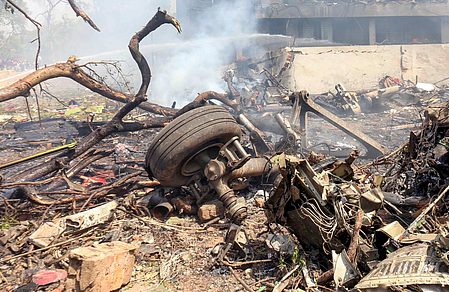Ahmedabad plane crash: Bird strike may have prevented jet from reaching optimum speed, experts say
Weather conditions were stable and clear at the time of the crash

Dubai: A bird strike may have prevented the Air India flight that crashed near Ahmedabad airport from reaching the optimum speed for takeoff, leading to the accident, aviation experts told NDTV.
Air India Flight 171, en route from Ahmedabad to Gatwick Airport in London, crashed around 1:30pm on Thursday, shortly after takeoff. The Boeing 787-8 Dreamliner was carrying 242 people — 230 passengers, 10 crew members, and 2 pilots.
A senior police officer in Ahmedabad told ANI that the London-bound aircraft crashed into a doctors’ hostel. He said police, firefighters, and other civic workers reached the spot within minutes. Rescue operations are still underway.
Weather conditions were stable and clear at the time of the crash, according to flight safety expert Marco Chan. The METAR (aviation weather forecast) reported light surface winds and visibility of six kilometres.
Chan added: “There were no significant clouds or weather phenomena reported — no indications of wind shear, storms, or other adverse conditions that might have contributed to the incident.”
Captain Saurabh Bhatnagar, former senior pilot, said: “It appears, prima facie, to be a case of multiple bird strikes, causing both engines to lose power.
The takeoff looked perfect. Just before retracting the landing gear, the aircraft began to descend — something that can only happen if the engines lose power or the aircraft stops developing lift. Of course, the investigation will confirm the actual cause.”
He added: “From the footage, the takeoff seemed uneventful. The aircraft descended in a controlled fashion. The pilot had issued a Mayday call, which indicates a distress situation.”
Aviation analyst Lazar commented: “That would explain why the aircraft couldn’t gain lift. If there were multiple bird hits during takeoff, it likely couldn’t sustain power beyond the six to seven-minute mark and began to fall. It’s also worth noting that this aircraft is relatively new — only 11 years old — so mechanical failure seems unlikely.”
Surprising at first glance
John McDermid, a computer scence professor at the University of York with expertise in safety engineering, said that while it was too early to know much about the cause of the crash it appeared to be very surprising at first glance.
While takeoffs and landings are the most dangerous phases of a flight, he noted that the plane had not climbed above 200 meters (650 feet).
“Pilots can abort takeoff until quite late,” McDermid told AP news agency. “So it seems like the problem occurred very suddenly in the final part of the takeoff roll, or shortly after takeoff, and was sufficiently serious to be unmanageable.”
He also said that jets have many backup systems, such as the ability to climb with only one engine, which also made it an unusual accident.
First Dreamliner
This is the first time a Boeing 787 Dreamliner has been involved in a crash of this nature since the model's launch 14 years ago. Just six weeks ago, Boeing celebrated the milestone of the Dreamliner fleet carrying over 1 billion passengers.
At that time, the company said its global fleet of more than 1,175 Dreamliners had completed nearly 5 million flights, logging over 30 million flight hours.
This crash is a major blow for Boeing, which has been struggling with a series of issues, including fatal crashes involving its 737 program.
It is also a new test for CEO Kelly Ortberg, who is approaching his first anniversary in the role. Ortberg was brought in to help the U.S. planemaker navigate a growing number of challenges that have raised questions about its long-term future.
Sign up for the Daily Briefing
Get the latest news and updates straight to your inbox
Network Links
GN StoreDownload our app
© Al Nisr Publishing LLC 2026. All rights reserved.
